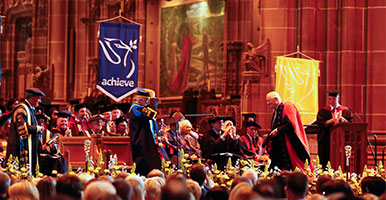Sir Antony Gormley
Presented by Professor Frank Sanderson
Honorable Pro-Chancellor, I have pleasure in presenting Antony Gormley for the award of an Honorary Fellowship of Liverpool John Moores University.
For more than a quarter of a century, sculptor Antony Gormley has been internationally recognized as having breathed new life into the use of the human form in sculpture. His public sculptures, frequently cast from his own body, have repeatedly explored the interaction between artistic images and the natural environment.
From the late 90s he has expressed himself on an increasingly ambitious scale, exemplified in such works as Another Place, The Angel of the North, Field, Inside Australia, and Quantum Cloud. His art is occasionally described as controversial but it is apparent that there is huge public interest in his work and that the controversy appears to stem from those critics who are uncomfortable with what has been described as the democratisation of art.
Antony Gormley was born in London in 1950, the youngest of seven children, to a German mother and devout Irish Catholic father who happened to be an art lover. "Sundays would always be church followed by visits to the British Museum or National Gallery", he recalls.
Antony followed his brothers to Ampleforth in Yorkshire where he single-mindedly pursued his interest in art. In 1968, he went to Trinity College, Cambridge, to read archaeology, anthropology and the history of art. He became more immersed in the contemporary art world and was soon earning money from painting murals for college events. Not long after graduating in 1971 he travelled to India to study meditation and Buddhism.
Intent on life as an artist, he returned to the UK and studied at the Central School of Art and Goldsmiths College, before completing his studies in 1979 with a postgraduate course in sculpture at the Slade School of Fine Art. It was at this time that he met and married Vicken Parsons.
Antony's breakthrough came with Field which has toured America, Europe and Asia. In 1993, Tate Liverpool showed Field for the British Isles made with the help of people aged from 7 to 70 in St Helens, Merseyside. This amazing work comprises 40,000 miniature terracotta figures and has been described by the artist as '25 tons of clay energised by fire, sensitised by touch and made conscious by being given eyes ... a field of gazes… and you become the subject of art's gaze rather than the other way round."
He adopted this collaborative approach in other works: Allotment in Malmö in 1996, Domain Field at the Baltic Centre for Contemporary Art, Gateshead in 2003, and Inside Australia at Menzies, Western Australia, also in 2003.
Particularly since winning the Turner Prize in 1994, Antony Gormley's work has been exhibited extensively, with solo shows throughout the UK in venues such as the Tate and Hayward Galleries, the British Museum and White Cube, and internationally at museums including the Louisiana Museum, the Corcoran Gallery of Art in Washington DC, the Irish Museum of Modern Art in Dublin, and the Kolnischer Kunstverein in Cologne. A major display of his work will open at the Hayward Gallery in the Spring of next year.
He is perhaps best known among the general public as the creator of the monumental Angel of the North, Britain's most famous work of public modern art. Five storeys high and with a wingspan as big as a jumbo jet's, it stands on a mound beside the A1 on the southern approaches to Gateshead. When first contacted in 1994 by Gateshead Council about a landmark sculpture, Antony was less than enthused, remarking, 'I don't do roundabout art.' Fortunately, the council persisted, Antony relented, and the Angel was erected in 1998. It is seen by 100,000 drivers a day and is visited by 150,000 people each year.
Closer to home, the Another Place display on Crosby beach has been hailed as one of the best examples of regeneration anywhere in the North West. Consisting of 100 cast-iron, life-size figures made from casts of Antony Gormley's own body and spread out along three kilometres of the foreshore, the artwork has attracted huge media interest in the area and tens of thousands of visitors since it was installed last July. The work is scheduled to be in place until November (although there is a strongcampaign to keep it there permanently) and forms part of Sefton Council's contribution to Liverpool's European Capital of Culture celebrations in 2008 and the 4th Liverpool Biennial in 2006.
In addition to the massive public recognition of his achievements, Antony Gormley has also enjoyed more formal recognition: In addition to the Turner prize:- He received an OBE in 1998 for services to public art He was awarded the South Bank Prize for Visual Art in 1999 He served on the Arts Council in the late 1990s, distinguishing himself as an articulate and passionate supporter of the arts He is an Honorary Fellow of the Royal Institute of British Architects, and of Trinity and Jesus Colleges, Cambridge And in 2003, he was appointed a member of the Royal Academy
Antony Gormley enjoys huge popularity with the general public. Through his talent, his drive and enthusiasm and his constant curiosity, he has made and continues to make a massive contribution to contemporary public art.
Antony has noted of Asian Field, currently on display in Sydney, that "If art is about trying to infect others with your madness, this has succeeded on a grand scale". We on Merseyside have first-hand experience of his success on a grand scale and we eagerly anticipate future expressions of his boundless creativity.
Thus I have pleasure in presenting Antony Mark David Gormley, OBE, this most distinguished person, for admission to our highest honour of Fellow of Liverpool John Moores University.



